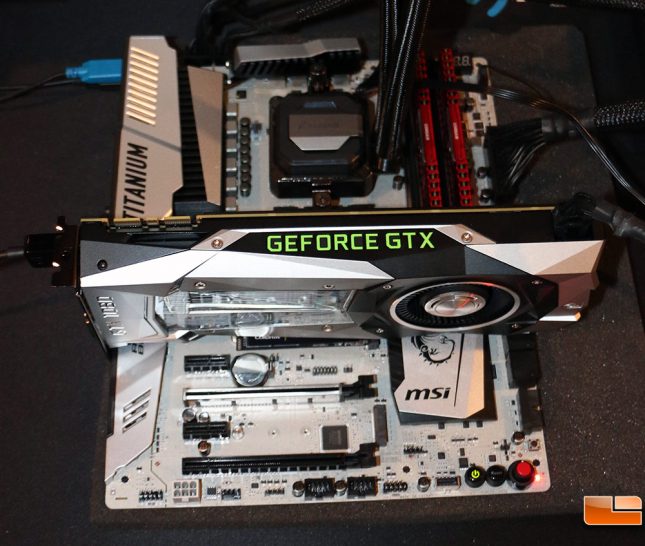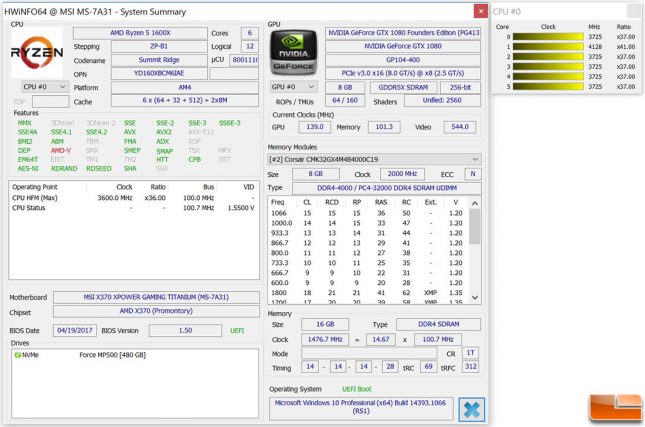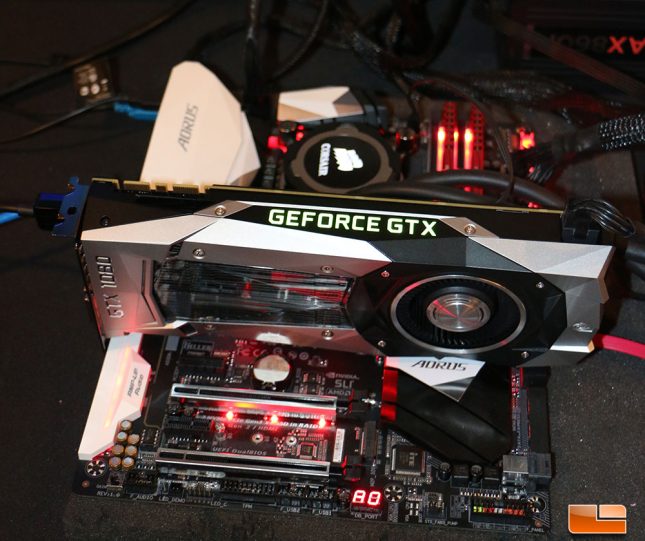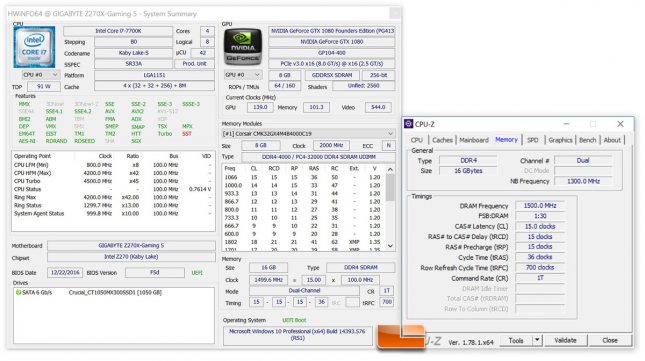AMD Ryzen 5 1600X Overclocked Benchmark Results At 4.1GHz
Our CPU Test Systems
Before we look at the numbers, lets take a brief look at the test system that was used. All testing was done on a fresh install of Windows 10 Pro Anniversary Update 1607 build 14393.10 64-bit and benchmarks were completed on the desktop with no other software programs running. We tested on five different desktop platforms (Intel Z77, Intel Z97, Intel Z270, Intel X99, AMD A4 and AMD AM3+) in this article, so we’ll just quickly touch on each as all shared common parts (CPU Cooler, Video Card, SSD, Power Supply) and only differed in the board, processor, memory kit and memory timings.
The AMD AM4 platform that we used to test the Ryzen 5/7 series processors was running the MSI X370 XPower Gaming Titanium Motherboard with UEFI 1.50 that came out on 4/19/2017. The Corsair Vengeance 16GB 4000MHz DDR4 dual channel memory kit was manually set to 2933MHz with 14-14-14 1T memory timings as we wanted to test with one of the most popular clock frequencies sold today. We used an NVIDIA GeForce GTX 1080 8GB Founders Edition video card with GeForce 376.33 WHQL drivers for all of the systems. We also used the Corsair AX860i digital power supply and a Corsair Force MP500 480GB PCIe SSD. A Corsair Hydro Series H110 water cooler for this review.
The Intel Z270 platform that we used to test the Intel 1151 processors was running the Gigabyte Aorus Z270X-Gaming 5 with UEFI F5e that came out on 12/28/2016. The Corsair Vengeance 16GB 4000MHz DDR4 dual channel memory kit was manually set to 3000MHz with 15-15-15-36 1T memory timings as we wanted to test with one of the most popular clock frequencies sold today. We used an NVIDIA GeForce GTX 1080 8GB Founders Edition video card with GeForce 376.33 WHQL drivers for all of the systems. We also used the Corsair AX860i digital power supply, Corsair Hydro Series H105 water cooler and Crucial MX300 1050GB SSDs on all of the desktop systems.
| Intel LGA1151 Test Platform | |||||
|---|---|---|---|---|---|
|
Component |
Brand/Model |
Live Pricing |
|||
|
Processor |
Intel Core i7-7700K |
||||
|
Motherboard |
Gigabyte Z270X-Gaming 5 | Click Here | |||
|
Memory |
16GB Vengeance 3000MHz DDR4 | Click Here | |||
|
Video Card |
GeForce GTX 1080 FE | Click Here | |||
|
Hard Drive |
Crucial MX300 1050GB | Click Here | |||
|
Cooling |
Corsair H105 | Click Here | |||
|
Keyboard |
Corsair K70 RGB | Click Here | |||
|
Mouse |
Corsair M65 Pro | Click Here | |||
|
Power Supply |
Corsair AX860i | Click Here | |||
|
Monitor |
ASUS VE278Q 27″ | Click Here | |||
|
Operating System |
Windows 10 64-Bit | Click Here | |||
Intel Z97 Platform:
The Intel Z97 platform that we used to test the Intel 1150 processors was running the ASUS Z97-A motherboard with BIOS 2801 that came out on 11/15/2015. The Corsair Dominator Platinum 16GB 2400 MHz DDR3 memory kit was set to 11-11-11-28 1T memory timings.
Intel Z77 Platform:
The Intel Z97 platform that we used to test the Intel 1155 processors was running the Gigabyte Z77X-UD5H (rev 1.0) motherboard with BIOS F16h that came out on 07/11/2016. The Corsair Dominator Platinum 16GB 2133 MHz DDR3 memory kit was set to 10-11-10-28 1T memory timings.
Intel X99 Platform:
The Intel X99 platform we picked to use for the LGA2011-v3 processors was the ASUS X99-E-10G WS board with BIOS 0403 and that is the initial release UEFI as no newer version has come out since the introduction of that board in 2016. The Corsair Vengeance 16GB 4000MHz DDR4 dual channel memory kit was manually set to 3000MHz with 15-15-15-36 1T memory timings.
AMD AM3+ Platform:
The AMD AM3+ platform that we used to test the AM3+ processors featured the ASRock Fatal1ty 990FX Killer motherboard with BIOS 1.60 that came out on 01/14/2016. The Corsair Dominator Platinum 16GB 2400 MHz DDR3 memory kit was set to 10-11-10-28 1T memory timings.
Laptops:
Just for fun we also included Dell XPS 13 9350 and Dell Dell XPS 13 9360 laptop results! These are retail Dell laptops with clean installs of Windows 10 Pro Anniversary Update 1607 build 14393.10 installed for comparison to the desktop platforms.
Let’s take a look at overclocking and move onto the benchmarks!




